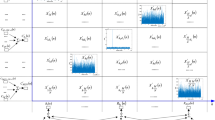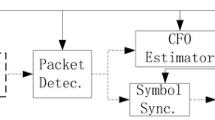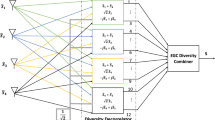Abstract
In order to meet the requirement of high gain and rapid transmission for direct-sequence spread-spectrum communication, the M-ary bi-orthogonal keying modulation mechanism has emerged. However, its unique control-code bit and spread-spectrum code-bit-processing mechanism lead to the difficult problem of signal reception and decision. The traditional related decision method has the issues of a large decision error and low efficiency. Therefore, considering the non-correlation characteristic between pseudocodes, a decomposition-combination correlation decision mechanism is proposed based on the principle of pseudocode combination equivalent to the background noise. The test results show that the method can accurately estimate the control-code bit and the spread-spectrum code bit, and the estimation accuracy and computation are better than those of the traditional methods.






















Similar content being viewed by others
References
Shen, B., & Wang, J.-X. (2017). Chip rate and pseudo-noise sequence estimation for direct sequence spread spectrum signals. IET Signal Processing,11(6), 723–733.
Gu, X., Zhao, Z., & Shen, L. (2016). Blind estimation of pseudo-random codes in periodic long code direct sequence spread spectrum signals. IET Communications,10(11), 1273–1281.
Zhu, L., Xiao, Z., Ge, N., & Lu, J. (2010). Channel frequency domain equalization algorithm for MBOK UWB systems. Journal of Tsinghua University Science and Technology,50(1), 140–144.
Zhu, L., Pei, Y., Ge, N., & Lu, J. (2011). Achievable rate analysis of MBOK modulation system over UWB channels. Journal of Tsinghua University Science and Technology,51(3), 400–404.
Xia, G.-F., Luo, Y., & Jin, Z.-S. (2015). Performance analysis and simulation of M-ary direct sequence spread spectrum system. Avionics Technology,46(2), 12–20.
Dou, Z., Sun, L.-X., & Sha, X.-J. (2012). Modulation mode and performance analysis of uwb communication system based on parallel combinatory spread spectrum. Journal of Harbin Institute of Technology,44(11), 46–50.
Hwang, J.-K., Chiu, Y.-L., & Chung, R.-L. (2008). Efficient bidirectional decision-feedback receiver for MBOK direct sequence. IEEE Transactions on Signal Processing,56(3), 1167–1177.
Wang, S., An, J., Ren, Y., Wang, T., & Bu, X. (2014). Compressed receiver for multipath DSSS signals. IEEE Communications Letters,18(8), 1359–1362.
Dai, W., Qiao, C., Wang, Y., & Zhou, C. (2016). Improved anti-jamming scheme for direct-sequence spread-spectrum receivers. Electronics Letters,52(2), 161–163.
Shen, Y., Wang, Y., Yu, X., & Wu, S. (2016). Fast cross-correlation mitigation via minimum mean-square error estimation based on matched filter outputs for consecutive DSSS signals. IEEE Transactions on Aerospace and Electronic Systems,52(4), 2044–2053.
Hao, C., Wei, G., & Jingdong, Y. (2008). Subspace decomposition-based correlation matrix multiplication. Journal of Systems Engineering and Electronics,19(2), 241–245.
Borio, D. (2013). Square wave decomposition for fast correlation in DSSS receivers. IEEE Transactions on Aerospace and Electronic Systems,49(2), 969–981.
Acknowledgements
This work was financially supported by the National Natural Science Foundation of China (Grant No. 61501309), the China Postdoctoral Science Foundation (Grant Nos. 2017T100185, 2015M580231), and the Liaoning Natural Science Foundation of China (Grant No. 2017011002-301).
Author information
Authors and Affiliations
Corresponding author
Additional information
Publisher's Note
Springer Nature remains neutral with regard to jurisdictional claims in published maps and institutional affiliations.
Rights and permissions
About this article
Cite this article
Liu, F., Jia, S. Decomposition-Combination Correlation Decision Mechanism for MBOK Signals. Wireless Pers Commun 110, 207–221 (2020). https://doi.org/10.1007/s11277-019-06721-3
Published:
Issue Date:
DOI: https://doi.org/10.1007/s11277-019-06721-3




